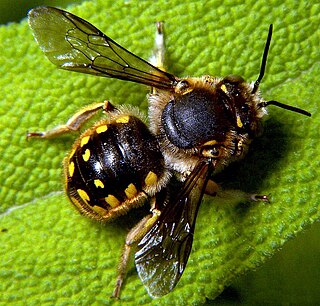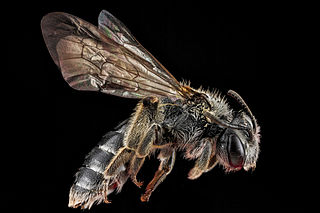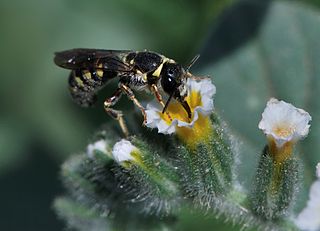
Megachilidae is a cosmopolitan family of mostly solitary bees. Characteristic traits of this family are the restriction of their pollen-carrying structure to the ventral surface of the abdomen, and their typically elongated labrum. Megachilid genera are most commonly known as mason bees and leafcutter bees, reflecting the materials from which they build their nest cells ; a few collect plant or animal hairs and fibers, and are called carder bees, while others use plant resins in nest construction and are correspondingly called resin bees. All species feed on nectar and pollen, but a few are kleptoparasites, feeding on pollen collected by other megachilid bees. Parasitic species do not possess scopae. The motion of Megachilidae in the reproductive structures of flowers is energetic and swimming-like; this agitation releases large amounts of pollen.
Diuris carinata, commonly known as the tall bee orchid, is a species of orchid that is endemic to the south-west of Western Australia. It has between four and six leaves and up to seven large, bright yellow flowers with reddish-brown markings.
Heriades parvula is a species of leaf-cutting bee in the genus Heriades, of the family Megachilidae. It is also spelled Heriades parvulus. It is a pollinator of Omphalogramma souliei and Teak

Macrotera is a genus of bees native to North America, particularly diverse in the desert regions of the United States and Mexico. According to Wilson and Carril, there are "around 30" species of Macrotera. Macrotera are small to medium sized and often black or reddish in coloration. The genus was treated by P.H. Timberlake who, in addition to T.D.A. Cockerell, described most of the known species. Macrotera used to be considered part of the genus Perdita but was split apart by C.D. Michener in 2000. Most species are extreme specialists (oligoleges) with respect to pollen and will only collect pollen from a few closely related species or genera of plants, particularly the plant genus Sphaeralcea and various Cactaceae.

Heriades is a genus of bees in the family Megachilidae. Fairly small and usually black, they are found all over the world. There are more than 130 species worldwide, roughly 25 species in North and Central America, but only 3 species are native east of the Rocky Mountains. European species such as H. truncorum can be found on the east coast of the US. Like other bees in the tribe Osmiini, Hoplitis and Ashmeadiella, they nest in cavities in wood excavated by other insects, or perhaps occasionally pine cones. They separate the cells of their nest with resin .
Sapyga louisi is a species of a club-horned wasp in the family – Sapygidae. Adults feed from flowers and the larvae are kleptoparasites of leaf cutter bee larvae, including those of Heriades carinata.

Osmiini is a tribe of leafcutter, mason, and resin bees in the family Megachilidae. There are about 19 genera and at least 1,000 described species in Osmiini.
Pleocoma carinata is a species of rain beetle in the family Pleocomidae. It is found in North America.
Macroteleia carinata is a species of parasitoid wasp in the family Platygastridae.

Sirthenea carinata is a species of corsair in the family Reduviidae. It is found in Central America, North America, and South America.
Ptilodactyla carinata is a species of toe-winged beetle in the family Ptilodactylidae. It is found in North America.

The Virginia miner bee is a species of miner bee in the family Andrenidae. Another common name for this species is the Virginia andrena. It is found in North America.
The Canada miner bee is a species of miner bee in the family Andrenidae. Another common name for this species is the Canada andrena. It is found in North America.
Corythaica carinata is a species of lace bug in the family Tingidae. It is found in the Caribbean Sea, Central America, and North America.

The cloudy-winged miner bee is a species of miner bee in the family Andrenidae. It is found in Central America and North America.

Paranomada is a genus of cuckoo bees in the family Apidae. There are at least three described species in Paranomada.

The hairy-belted miner bee is a species of miner bee in the family Andrenidae. Another common name for this species is the hairy-banded andrena. It is found in North America.

Heriades leavitti is a species of bee in the family Megachilidae. It is found in North America.

Ochreriades is a genus within Megachilidae. This taxon has been considered the sister lineage "to a clade consisting of the “core” Osmiini, the tribe Megachilini and the genera Pseudoheriades and Afroheriades."

The term polylecty or generalist is used in pollination ecology to refer to bees that collect pollen from a range of unrelated plants. Honey bees exemplify this behavior, collecting nectar from a wide array of flowers. Other predominantly polylectic genera include Bombus, Ceratina, Heriades and Halictus. The opposite term is oligolecty, and refers to bees that exhibit a narrow, specialized preference for pollen sources, typically to a single family or genus of flowering plants.











